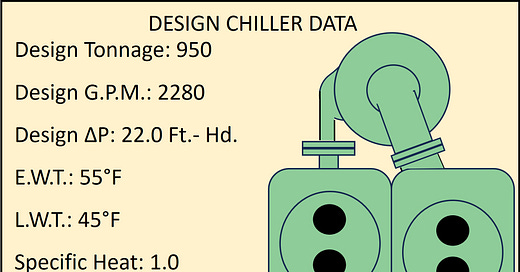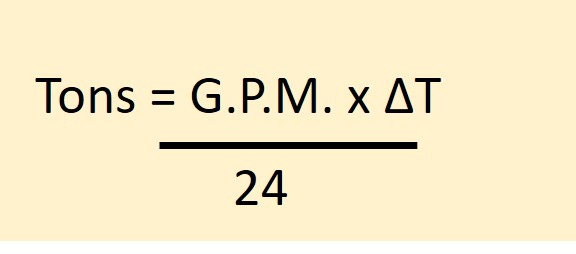6-2-2025 The HVAC&R Weekly Edition: Issue #17
Hey, it's just a little Propylene Glycol, what could be the harm?
I saw a recent video post by John Clemmer the administrator for The Chiller Guys Hub in which he was reviewing some fundamentals on Chilled Water Systems and the design flow values and formulas that we often use to verify capacity and performance. It prompted me to put together a presentation for my U.A. Service Apprentices regarding chiller flow design and how Propylene Glycol affects its performance.
Admittedly it is a little deep for a 1st Year Apprentice to fully grasp, but the purpose of the presentation was to give them something to think about when or if the situation presents itself. Or it could be used to analyze or explain the poor performance a Chiller may be experiencing. Deep or not, I made the presentation. It was that presentation and John Clemmer’s video, which inspired this Edition #17. If you get a moment you might want to check out his work, it’s very informative.
Analyzing the ramifications of arbitrarily adding Propylene Glycol to a Chilled Water System, although done with the best of intentions, can come with some penalties associated with that decision. We’re going to look at some common assumptions that can lead to those performance penalties.
First a look at a water cooled Chiller’s performance as it was intend by the chiller manufacturer and the design engineer using pure water.
Adding Glycol to our system as a means of freeze protection at the AHU, with no regard for the changes in the solutions Specific Heat and Specific Gravity values.
Adding Glycol to our system and adjusting for the new Specific Heat and Specific Gravity but not changing the design GPM to compensate for those changes.
How to add Glycol to our system and make adjustments to the system pressure drop and design flow to produce the original rated capacity of the Chiller.
How adding Glycol affects centrifugal pump Horsepower. The often overlooked Achilles Heel in that fateful decision.
FIRST LET’S REVIEW SOME FUNDAMENTALS:
Here is a basic formula that is often used to calculate the sensible heat added or removed from Heat Transfer Equipment. When the median is pure water we usually used the factored constant 500 and apply it to this formula.
The “500” is the product of the weight of 1 gallon of water 8.33 lbs., the Specific Heat of Water 1.0, the Specific Gravity of water 1.0, and the minutes in an hour 60.
This becomes much more relevant when we start our discussion about adding glycol to a heat transfer median.
When working with Chilled Water systems we could use the equation introduced above to find the BTU/Hrs. and then divide that answer by 12,000 B.T.U./Hr. to find the Tons of cooling per hour. Service mechanics being who they are, are always looking for ways to simplify a task. In that effort, a modified version of that Sensible Heat formula was developed.
Now I suppose if you’re like me, you’re asking yourself; “where the heck did that “24” come from?”
If you take 12,000 ÷ 500 = 24: There are 12,000 BTU/Hr. per ton of refrigeration, and we used that 500 number we just broke down a moment ago. This is important to remember because soon we will be making out own “500” and “24” constants when we switch our Chilled water system to glycol.
A Chiller’s performance as it was intend by the chiller manufacturer and the design engineer using pure water.
If we apply several of the formulas we just introduced we can confirm the capacity as its listed.
Starting with this Sensible heat formula we can confirm the design capacity:
We can also use the modified formula.
Appling the formula gives the same results.
Now that we’ve established that these formulas provide the degree of accuracy we require to assess a systems performance. Lets see what happens when some well intentioned person adds Propylene Glycol to the system. I’m going to show several examples and the errors that can be made when checking performance
Adding Glycol to our system as a means of freeze protection at the AHU, with no regard for the changes in the solutions Specific Heat and Specific Gravity values.
To show the effects, we need to create our own “500” number, and calculate the actual GPM, accounting for the change in density from pure water to a solution with a Specific Gravity of 1.035.
Here is our problem using the new “500” number.
We also need to find the change in GPM flow with the change in Specific Gravity to 1.035. The new Ft.-Hd.
If we don’t compensate for either of these changes, simply using the original Pressure Drop of 22.0 Ft.-Hd. and assume that at that pressure drop the machine is receiving the design flow of 2,280 GPM, we’ve made two assumptions that will send us down the wrong path.
The corrected GPM 2,244 results in a loss of about 9% capacity or about 84.2 Tons.
3. Adding Glycol to our system and adjusting for the new Specific Heat and Specific Gravity but not changing the design GPM to compensate for those changes.
If we correct for the change in density to 22.7 Ft.-Hd. and the Specific Heat to 1.035 but use the Original design flow of 2,280 GPM we will still see a loss of about 7.4% in capacity or about 70.3 Tons.
So as you can see without making adjustments to our calculations based on our readings we may not be getting the true performance profile. Next week we will look at how we can get back to the original design performance by increasing the flow. We will explain how we can come up with our own (GPM x ∆T) ÷ 24 = Tons formula for finding the chiller’s capacity when using a Propylene Glycol solution. We will also look at how the change in Specific Gravity affects a centrifugal pump in terms of Horsepower. That potential Achilles Heel I mentioned earlier
Feel free to post a comment or ask a question, I will try to give you an answer.
Be safe and I will talk to you next week.



















Kevin Giest. Finally got around to putting this Session together. I’m sure some of this looks familiar. Thanks for the ❤️
Hope your summer is going well.